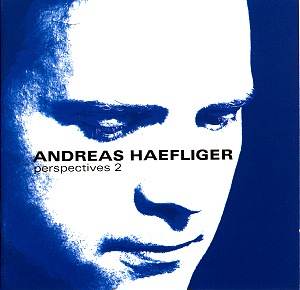Sequels, somewhat notoriously,
rarely live up to the promise of the
original. Here, for once, is the exception.
In Perspectives 1, a brave mix
of Beethoven, Adès, Schubert
and Mozart (review
), it was Beethoven's Op. 111 that impressed
the least. Perhaps it was overly ambitious
to put the last sonata of the 32 on
the first disc. Opp. 54 and 90, here,
find Haefliger in much more responsive
mood.
The first movement
of Op. 54 is built on contrast, between
the almost Schubertian lyricism of the
opening figure and the more menacing
bare octaves - I believe Brendel referred
to these as 'beauty and the beast',
although I stand to be corrected. Haefliger
seems almost to over-beautify the opening
figure to enhance the contrast - a quite
acceptable strategy. The moto perpetuo
finale is very much 'his thing',
light and imbued with an apposite sense
of inevitably.
Some Bartók
is sandwiched in between the two Beethovens.
Out of Doors has its first movement
('With drums and pipes') finding its
affinities with the Allegro barbaro,
yet Haefliger never bangs the piano.
There is a dance-like basis to all of
this. The calm of the 'Barcarolla' gives
way to the playful 'Musette', but it
is the Night Music of the fourth
movement that finds this pianist at
his finest. There is breathtaking concentration
here. The finale is an apt tonic, energetic
and with abandon yet, as the studio
conditions would imply, mightily accurate.
Beethoven's E minor
Sonata, Op. 90 is an inspired work to
follow. Haefliger seems to deliberately
warm his tone to ensure maximum post-Bartókian
contrast. Interestingly, he is unafraid
to verge on the martellato later to
ensure contrasts within the movement,
before melting into welcome lyricism.
His legato touch is shown off in a finale
that flows magnificently.
Better than all of
this, though, is the mighty Brahms F
minor Sonata. The very opening requires
great chordal command as well as great
Romantic swagger. It turns out that
Haefliger has both in spades - the swagger
returns most obviously in the Scherzo.
The contrast to the work's opening gestures
seethes in most Brahmsian fashion, the
recording capturing the warmth of the
pianist's tone to perfection. The real
storm clouds of the development are
memorable.
Delicacy is the watchword
of Haefliger's 'Andante espressivo',
where he really seems to commune with
the great composer. Note also how he
maintains an admirable legato at levels
of forte and above. But if there is
one movement that surpasses the rest
it is the Intermezzo fourth movement,
its lonely, fragmented world projected
in playing of great maturity.
It is interesting to
track Haefliger's career. On the present
evidence this is a career that is moving
from strength to strength. By providing
essentially a recital experience on
CD, the strength of comparisons with
other pianists' recordings of individual
works is weakened. Well worth investigating.
Colin Clarke
Sequels rarely live up to the promise
of the original. Here, for once, is
the exception ... Haefliger's is a career
that is moving from strength to strength.
... see Full Review


